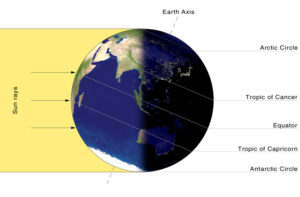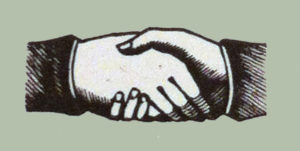Ask a child to draw our spherical planet on a piece of paper or on a chalkboard and most likely what they’ll draw is a circle. How perfect is the circle? No beginning, no end. The shape that best describes our seasonal round. The seasons, a result of our planet’s tilt on its axis. Scientific evidence suggests that some four and a half billion years ago an object the size of Mars collided with our planet. This incredible, explosive impact resulted in a huge chunk of the Earth spinning off into space, becoming the satellite we call the Moon. The collision also knocked our planet dramatically off kilter, causing the Earth to orbit the sun on a slant. It is that slant––about 23.5 degrees––that creates our seasons.
And at this particular juncture tomorrow on the 21st of December––the Midwinter Solstice in the Northern Hemisphere––the North Pole is tilted the farthest from the sun as it will get. It is our hemisphere’s longest night. The South Pole is tilted the closest to the sun as it will get, creating for the Southern Hemisphere the longest day. There, it is the Midsummer Solstice.
The precise moment of this event this year is at 11:28 AM Eastern Standard Time on December 21. If you are one who watches the travels of the sun in the sky, it will appear for a few days like the sun is standing still, getting no lower or higher, and this is the source of the word solstice, from the Latin sol stetit, “sun stands still.” In reality, things are slowly shifting. Already tomorrow the days in our Northern Hemisphere will begin to increase in length proportionately with their decrease in the Southern Hemisphere. It is the constant sway back and forth, the constant exchange between hemispheres… the explanation behind our seasonal round that helps us count our days and years and gives us grounding as humans on Planet Earth.
The changing seasons, subtle as the change is here in Lake Worth, have fascinated me since I can remember. This great mechanical clockwork fascinates me, too. And so on the 21st in our particular spot on this amazing spinning planet––26.6168º North, 80.0684º West––Seth and I will light a fire to mark the solstice night. Seth will build the fire in the copper fire bowl in the back yard, fueled by the remnants of our Christmas tree from last year, which we brought out to a corner of the yard some time after Twelfth Night last January. It’s sat there all these months, shedding needles, drying, and still for all the world smelling like Christmas, even through spring and summer and fall, and it is good, it is right to have this reminder of Old Father Christmas in our lives all the year long. We will sit at the fire that he provides under the starry night sky and toast him with mulled wine and roasted chestnuts. In this small way we pull down the celestial mechanics of our planet and bring it directly to our tiny dot in this universe, and into our hearts, too: the old Yuletide illuminating and welcoming the new, connecting us with the past as we continue to forge that circle, no beginning, no end. With it, we know that Christmas is surely almost here. And so we welcome Yule.
Image: The particular beauty of the science of the Winter Solstice, depicted in a chart created by Przemyslaw “Blueshade” Idzkiewicz. It is the Illumination of Earth by Sun on the Day of Winter Solstice on Northern Hemisphere [CC 2005 via Wikimedia Commons]. By the time the Earth progresses another six months on its annual journey around the sun, the sun will be illuminating the North Pole and the South will be experiencing darkness; that will be Midsummer Solstice in the North. Back and forth again and again… the subtle daily shift, the constant rearrange.


